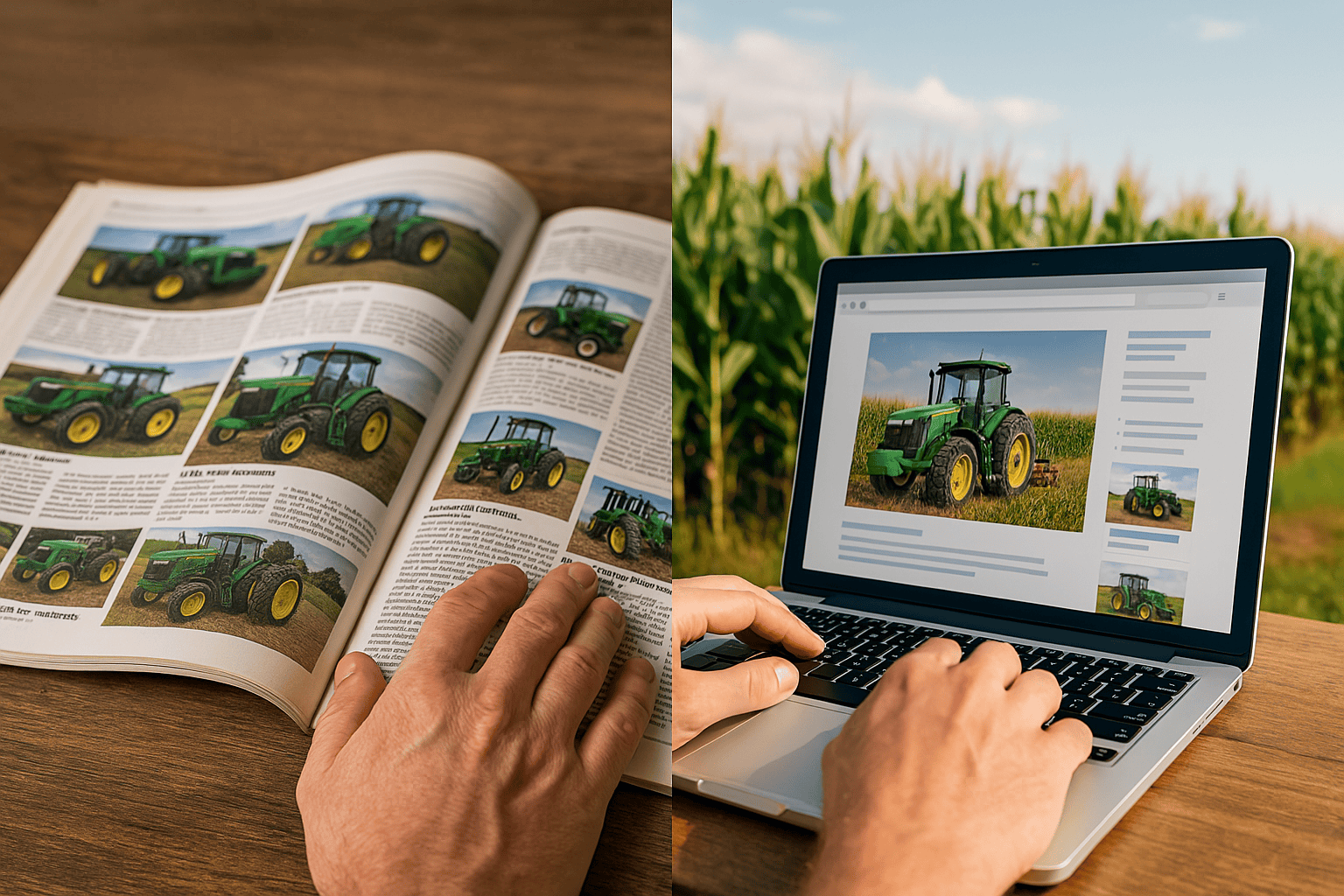Why Your Ag Business Needs the Right Marketing Strategy
Every agricultural business is unique, with different products, target audiences, and sales goals. Whether you’re an equipment dealer, seed supplier, or Ag service provider, choosing the right marketing strategy can mean the difference between wasted budget and real business growth.
This guide breaks down print vs. digital advertising, social media platforms, email vs. direct mail, and SEO vs. PPC so you can determine which strategies will deliver the best results for your ag business.
1. Print Ads vs. Digital Ads: What Works Best for Equipment Dealers?
Print and digital advertising both have a place in agricultural marketing—but which one is better for your business?
✅ Print Advertising (Fastline Catalog, Direct Mail)
- Best for: Brand trust, long-term engagement, and reaching farmers who prefer physical materials.
- Strengths: Stays in farm offices and trucks for months, reinforcing your brand over time.
- Best Used With: QR codes linking to product pages or landing pages for tracking engagement.
✅ Digital Advertising (Google PPC, Social Media Ads)
- Best for: Immediate lead generation and driving website traffic.
- Strengths: Geo-targeted and interest-based targeting reaches high-intent buyers.
- Best Used With: Re-targeting campaigns to stay in front of potential customers who have engaged with your ads.
🔍 Key Takeaway: Equipment dealers should consider a mix of print and digital marketing for maximum exposure and lead generation.

2. Social Media: Should You Focus on Facebook, LinkedIn, or YouTube?
Farmers and Ag professionals use social media differently than other industries. Choosing the right platform depends on your audience.
- Best for: Community engagement, event promotions, and product updates.
- Key Features: Facebook Groups, Marketplace, and paid ads for geo-targeting farm owners.
- Best for: B2B networking, equipment dealer connections, and industry leadership.
- Key Features: Professional content, industry discussions, and corporate partnerships.
✅ YouTube
- Best for: Product demonstrations, customer testimonials, and educational content.
- Key Features: Farmers rely on YouTube for tutorials, equipment reviews, and how-to videos.
🔍 Key Takeaway: Use Facebook for brand awareness, LinkedIn for industry networking, and YouTube for high-value content that educates and converts.
3. Email Marketing vs. Direct Mail: Which Converts Better?
Email and direct mail are both powerful tools for ag marketing. Which one works best depends on your audience’s preferences and your campaign goals.
✅ Email Marketing
- Best for: Engaging current leads, sending product updates, and nurturing customer relationships.
- Strengths: Cost-effective, measurable open rates, and easy to segment audiences.
- Best Used With: Automated follow-up sequences and retargeting ads.
✅ Direct Mail
- Best for: Farmers who prefer physical materials and don’t check emails often.
- Strengths: High open rates, tangible impact, and less digital competition.
- Best Used With: Personalized messaging, QR codes linking to online content, and special offers.
🔍 Key Takeaway: Use email for frequent touch-points and direct mail for high-impact campaigns that stand out.
4. SEO vs. PPC: Long-Term Growth vs. Instant Traffic
Both SEO (Search Engine Optimization) and PPC (Pay-Per-Click Advertising) help drive traffic to your website, but they serve different purposes.
✅ SEO (Long-Term Growth)
- Best for: Ranking higher on Google for keywords like “best farm equipment dealers near me.”
- Strengths: Organic, sustainable growth with lower long-term costs.
- Best Used With: Blog content, internal linking, and optimized Google Business Profiles.
✅ PPC (Instant Traffic)
- Best for: Quickly driving targeted traffic to product pages or special offers.
- Strengths: Immediate visibility, especially for high-value equipment listings.
- Best Used With: Re-targeting campaigns, landing pages optimized for conversions.
🔍 Key Takeaway: SEO is a long-term investment, while PPC delivers quick wins. A successful Ag marketing strategy should balance both.
5. Case Study: How One Ag Business Used Multi-Channel Marketing to Increase Leads
Challenge: A regional tractor dealership wanted to increase both online and in-store sales but wasn’t sure where to focus its marketing budget.
Strategy:
- Ran targeted Facebook and Google Ads to drive leads.
- Used SEO-optimized blog content to attract organic traffic.
- Sent direct mail pieces with QR codes leading to exclusive promotions.
- Launched a YouTube series featuring customer testimonials and product demonstrations.
Results:

🔍 Key Takeaway: Multi-channel marketing works. Combining digital and print strategies maximizes reach and conversions.
What’s the Best Strategy for Your Ag Business?
The best marketing strategy depends on your specific business goals, budget, and target audience. A successful ag marketing plan isn’t about choosing one channel—it’s about integrating multiple tactics for maximum impact.
Recommended Strategy Based on Your Business Type:
- Equipment Dealers: Mix of print (Fastline Catalog), PPC, and YouTube product demos.
- Seed & Input Suppliers: Focus on Facebook ads, email marketing, and SEO-driven blog content.
- Ag Service Providers: Leverage LinkedIn networking, targeted direct mail, and PPC campaigns.
At Fastline Marketing Group, we specialize in helping Ag businesses develop custom marketing strategies that deliver real results. Whether you’re looking for SEO, PPC, social media, or print advertising, our team is here to guide you.
📞 Let’s discuss the best marketing mix for your business—Contact us today!


